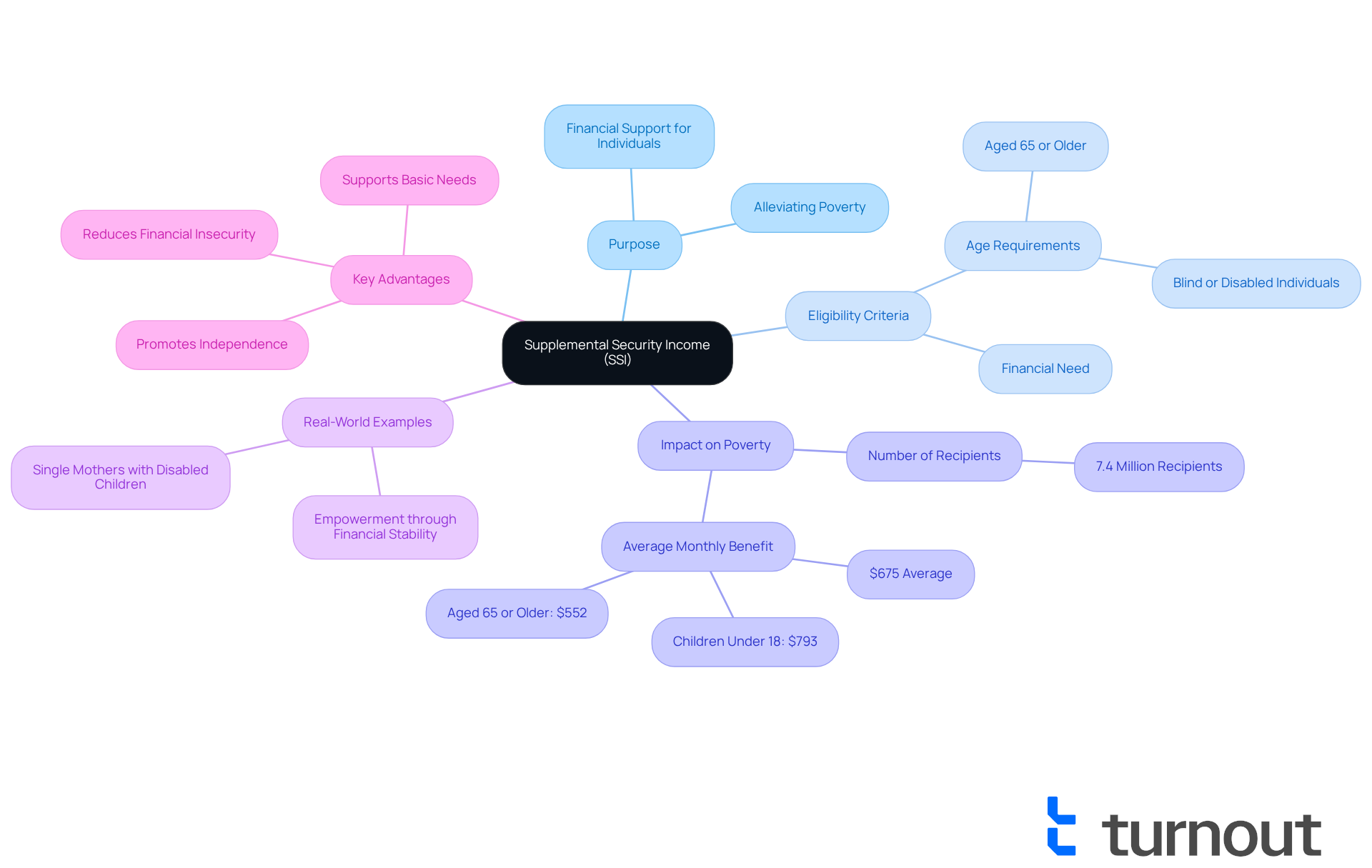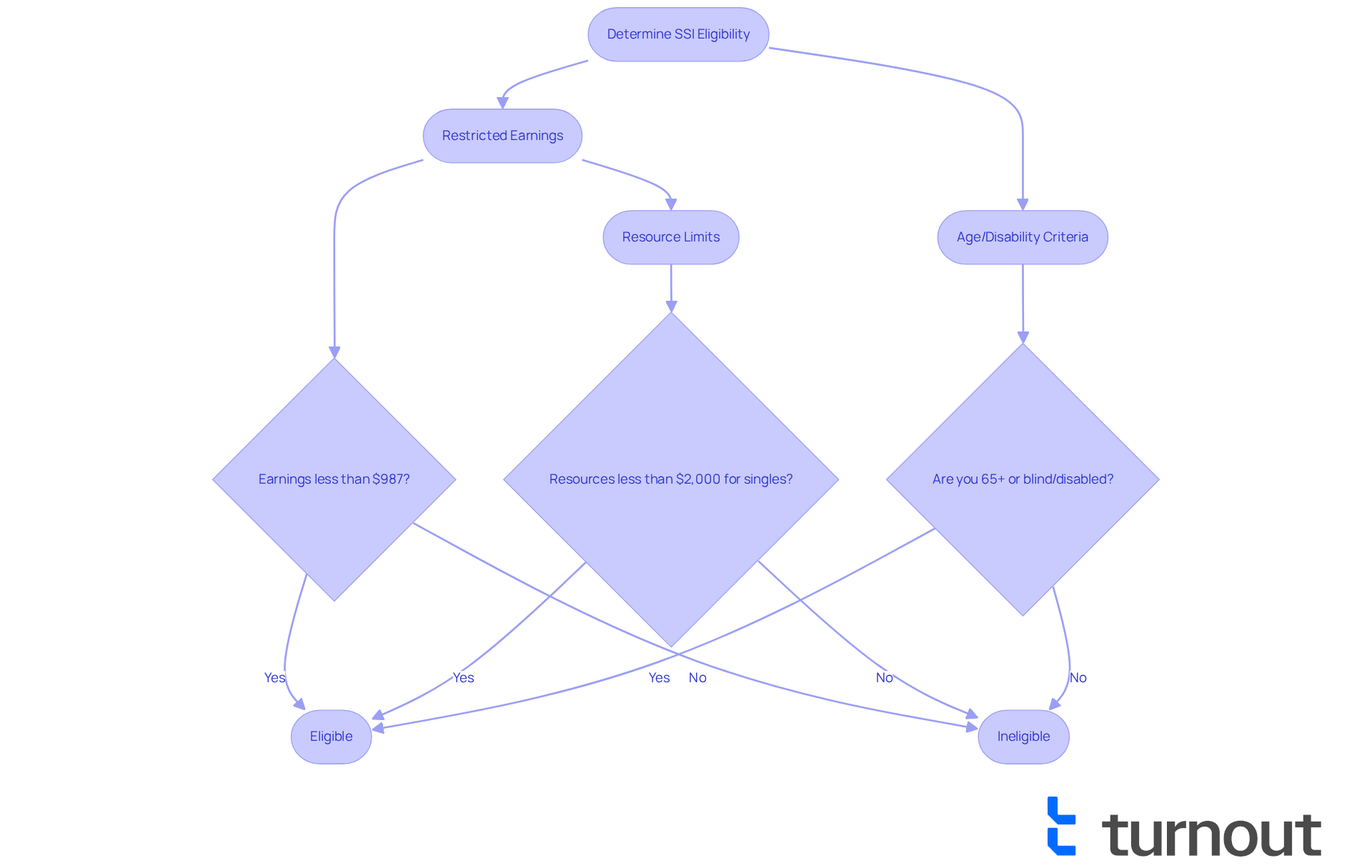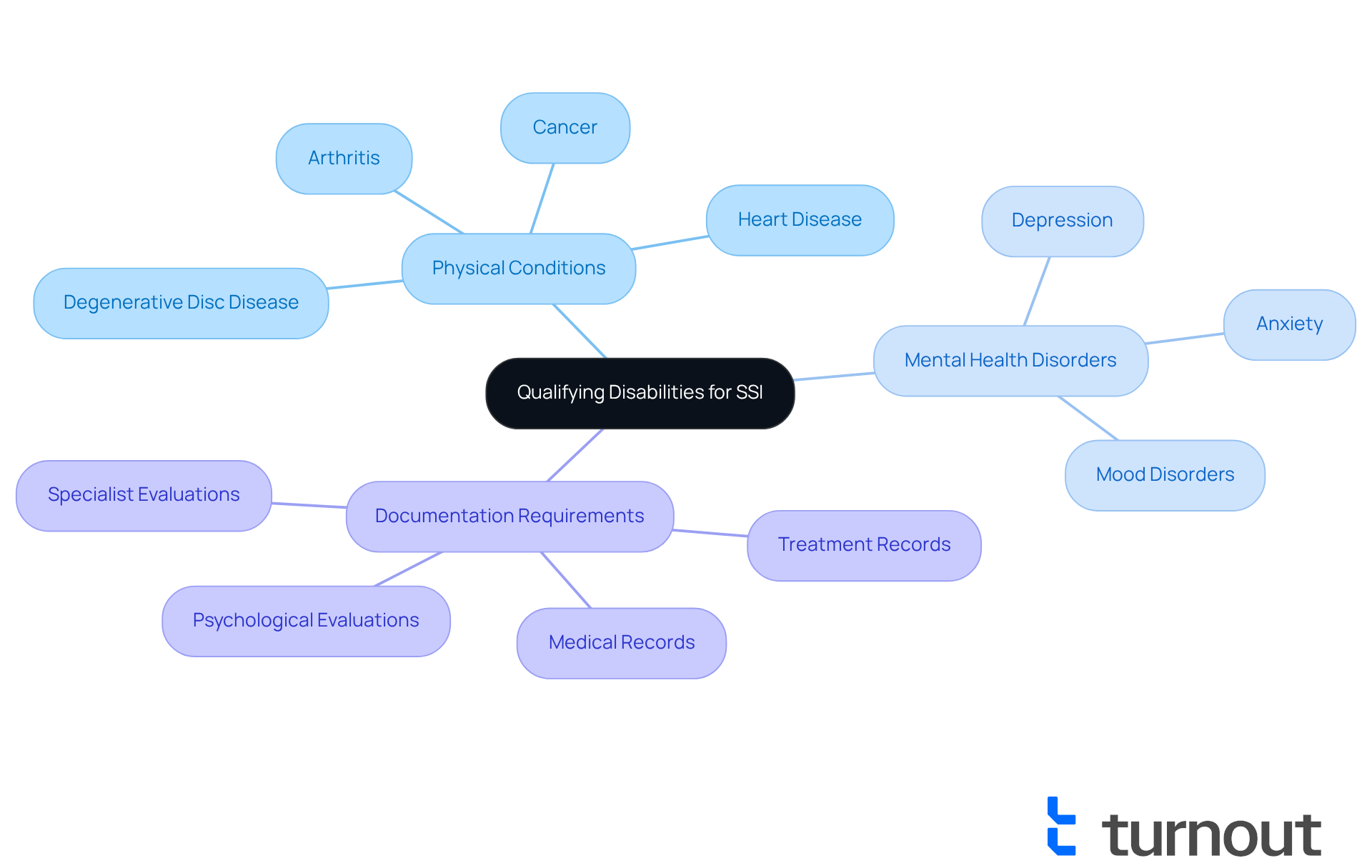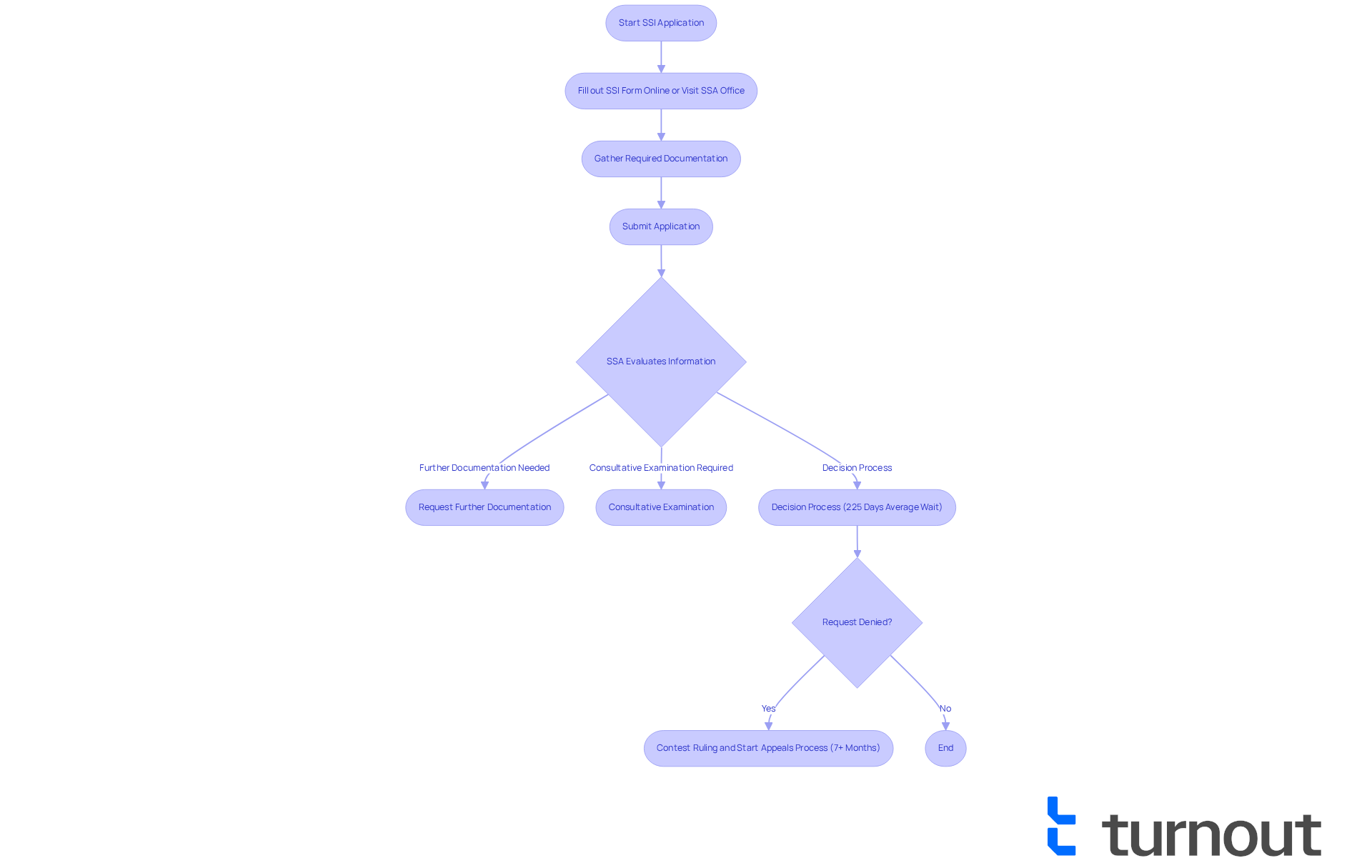Overview
Navigating the qualifications for Supplemental Security Income (SSI) can feel overwhelming, especially when you're facing financial challenges. This program is designed for individuals who are aged 65 or older, blind, or disabled, and it focuses on those with limited income and resources. We understand that meeting specific financial criteria can be daunting, but it's essential to know that these guidelines are in place to help those in genuine need.
The article outlines the strict income and resource limits, as well as the various types of disabilities recognized by the Social Security Administration. By highlighting these qualifications, we aim to ensure that assistance is directed to those who truly require support. Remember, you are not alone in this journey; we’re here to help you navigate these requirements and find the assistance you deserve.
Introduction
Understanding the intricacies of Supplemental Security Income (SSI) is essential for millions who rely on this vital financial support. We understand that navigating this system can feel overwhelming, especially for those with limited income and resources. SSI serves as a crucial safety net, alleviating poverty for many, particularly among the elderly and disabled populations.
However, you may wonder: what exactly qualifies an individual for these benefits? This article will explore the qualifications for SSI, the application process, and the significant impact this program has on enhancing the lives of its recipients.
We're here to provide clarity and guidance as you navigate this important aspect of social welfare, ensuring you know that you are not alone in this journey.
Defining Supplemental Security Income (SSI)
Supplemental Security Income (SSI) is a federal assistance program designed to provide financial support to individuals with limited income and resources. It primarily assists those aged 65 or older, as well as blind or disabled individuals, ensuring they can meet their basic needs for food, clothing, and shelter. Unlike Social Security benefits, which depend on work history, SSI is based on need. This means that what qualifies for SSI is determined by financial criteria, not by employment history. This program is crucial in alleviating poverty among vulnerable populations, serving as a safety net for those who might otherwise struggle to make ends meet.
The impact of SSI on poverty alleviation in the U.S. is profound. As of December 2023, approximately 7.4 million people received SSI payments, with the average monthly benefit being $675. This financial assistance is essential for many, particularly for individuals with disabilities who often face additional barriers to employment. For example, a single mother with a disabled child may rely on SSI to cover essential expenses, enabling her to provide a stable home environment.
Social workers highlight the importance of SSI in helping families maintain their dignity and meet basic needs. One social worker shared, "SSI is often the difference between living in poverty and having a chance at a better life." This sentiment resonates in real-world examples where SSI has empowered individuals to afford necessary medical care, secure stable housing, and access nutritious food.
The key advantages of SSI for at-risk groups include its role in reducing poverty levels among disabled individuals, highlighting what qualifies for SSI. The program not only offers financial assistance but also promotes independence by allowing recipients to focus on their health and well-being without the constant worry of financial insecurity. In fact, studies indicate that SSI has played a vital role in lifting many recipients above the poverty line, underscoring its critical importance in the social safety net.

Eligibility Requirements for SSI Benefits
Applicants must understand what qualifies for SSI benefits by meeting specific criteria. We understand that navigating these requirements can be overwhelming. Primarily, applicants must demonstrate restricted earnings, which encompass wages, pensions, and various other revenue sources. For 2025, the earnings threshold is set at $987 monthly for single persons. Additionally, it's important to note that applicants must adhere to strict resource restrictions, with a maximum permissible resource limit of $2,000 for single individuals and $3,000 for couples. Resources include cash, bank accounts, stocks, and bonds, although certain assets, such as a primary residence and personal belongings, are excluded from this calculation.
Moreover, applicants must be aged 65 or older, blind, or disabled as defined by the Social Security Administration (SSA). This comprehensive set of criteria clarifies what qualifies for SSI benefits to ensure they are allocated to those who genuinely require financial assistance. For instance, a person with monthly earnings of $800 and assets amounting to $1,500 would qualify for SSI, while someone earning $1,200 monthly would surpass the earnings threshold and be disqualified.
Financial advisors suggest that individuals diligently manage their earnings and resources to understand what qualifies for SSI benefits and preserve eligibility. It's common to feel uncertain about how these limits apply to your situation. Remaining aware of these thresholds and understanding how different types of income affect eligibility is essential for those navigating the SSI enrollment process. Remember, you are not alone in this journey, and we're here to help you every step of the way.

Qualifying Disabilities and Conditions for SSI
[What qualifies for SSI](https://myturnout.com/faqs) includes a wide range of disabilities, covering various physical and mental health conditions. The Social Security Administration (SSA) has a list of impairments that automatically qualify for benefits, covering severe conditions such as cancer, multiple sclerosis, and significant intellectual disabilities. If you have a medical condition that substantially impairs your ability to perform basic work activities, it is important to understand what qualifies for SSI. This can include chronic illnesses, mental health disorders, and disabilities resulting from injuries.
To support your claim, it's essential to provide comprehensive medical documentation. The SSA requires detailed evidence of the severity and impact of your condition on daily functioning. For example, conditions like arthritis, heart disease, and degenerative disc disease are among the most commonly approved disabilities. Their prevalence and severity often lead to successful claims. In fact, approximately 60% of SSI recipients under age 65 are diagnosed with a mental disorder, highlighting how important mental health is in determining eligibility.
The SSA's Blue Book outlines various conditions that clarify what qualifies for SSI, emphasizing the need for thorough documentation. Medical professionals stress that providing consistent treatment records, test results, and specialist evaluations is crucial for establishing the credibility of your claim. This documentation not only demonstrates the severity of your disability but also illustrates how it prevents substantial gainful activity, which is essential to understanding what qualifies for SSI. Remember, you are not alone in this journey; we are here to help you navigate the process.

Navigating the SSI Application Process
Navigating the SSI procedure can feel overwhelming, but understanding the necessary steps can make it more manageable. We recognize that this journey can be challenging. Candidates can start by filling out the SSI form online via the SSA's website or by visiting their nearby SSA office. It’s important to gather all required documentation, such as proof of income, resources, and medical records that support your disability claim. Recent updates to the submission procedures aim to simplify this process, introducing online forms that prepopulate answers based on existing records.
Once your submission is made, the SSA will evaluate the information and may request further documentation or arrange a consultative examination. We understand that the decision process can take several months; current average wait times for initial decisions are around 225 days, which is significantly higher than pre-pandemic levels. It’s common to feel anxious during this time, so we encourage candidates to check on their status consistently.
If a request is rejected, remember that you have the right to contest the ruling. The appeals process can be lengthy, often taking an additional 7 months or more, but advocacy services are available to assist you in navigating this complex journey. It's important to know that around 62% of initial SSDI requests are denied nationwide, highlighting the significance of comprehensive documentation and preparation.
Advocacy groups emphasize the challenges faced by applicants, noting that increased wait times and complex requirements can lead to significant financial hardship for vulnerable individuals. By understanding the documentation needed and the steps involved, you can better prepare for the SSI application process and gain clarity on what qualifies for SSI, improving your chances of success. Remember, you are not alone in this journey; we’re here to help you every step of the way.

Conclusion
Supplemental Security Income (SSI) is more than just a financial program; it serves as a vital lifeline for individuals facing economic hardships due to age, blindness, or disability. We understand that navigating these challenges can be overwhelming, and knowing what qualifies for SSI is essential for those in need. This program offers a safety net that ensures basic needs are met, focusing on financial need rather than work history, which underscores its role in alleviating poverty among our most vulnerable populations.
In this article, we delve into the eligibility requirements, highlighting specific financial thresholds and the necessary documentation to support claims. It's common to feel uncertain about the process, but understanding both income and resource limits is crucial. Navigating the SSI application process requires careful attention to detail, and the insights shared about qualifying disabilities further illustrate the breadth of conditions that can lead to eligibility. Comprehensive medical documentation plays a significant role here.
The significance of SSI cannot be overstated. It not only helps individuals maintain their dignity and independence but also plays a crucial role in reducing poverty levels across the nation. For those who believe they may qualify, taking proactive steps to understand the application process and requirements is essential. Engaging with advocacy resources and staying informed can empower you to secure the financial support you need to thrive. Remember, you are not alone in this journey; we're here to help you every step of the way.
Frequently Asked Questions
What is Supplemental Security Income (SSI)?
Supplemental Security Income (SSI) is a federal assistance program that provides financial support to individuals with limited income and resources, primarily assisting those aged 65 or older, as well as blind or disabled individuals.
How does SSI differ from Social Security benefits?
Unlike Social Security benefits, which depend on an individual's work history, SSI is based on financial need. Qualification for SSI is determined by financial criteria rather than employment history.
What is the impact of SSI on poverty alleviation in the U.S.?
SSI has a profound impact on poverty alleviation, with approximately 7.4 million people receiving payments as of December 2023. The average monthly benefit is $675, which is essential for many individuals, particularly those with disabilities who face additional barriers to employment.
How does SSI benefit families and individuals?
SSI helps families maintain dignity and meet basic needs, allowing individuals to afford necessary medical care, secure stable housing, and access nutritious food. It can be the difference between living in poverty and having a better quality of life.
What are the key advantages of SSI for at-risk groups?
Key advantages of SSI include its role in reducing poverty levels among disabled individuals and promoting independence by allowing recipients to focus on their health and well-being without constant financial insecurity.
How has SSI affected poverty levels among its recipients?
Studies indicate that SSI has played a vital role in lifting many recipients above the poverty line, highlighting its critical importance in the social safety net for vulnerable populations.




